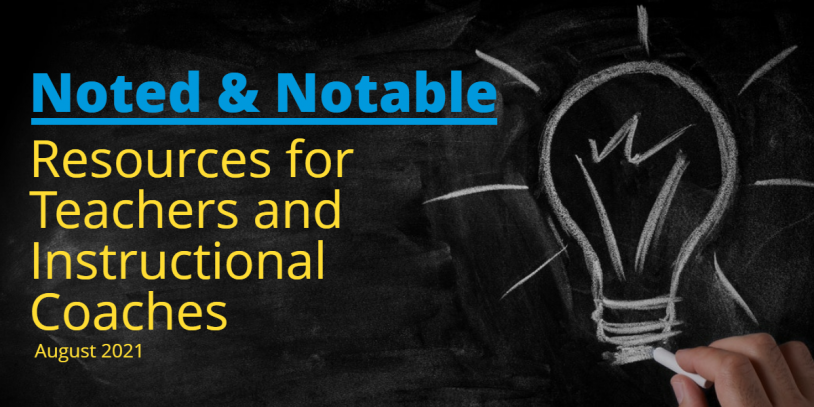Resources for Teachers and Instructional Coaches – August 2021

It’s August, which means … back-to-school season! Resources for teachers abound, but who has the time to sift through them all?
Here are our top picks for important August reads and resources for teachers and school leaders, to get the school year off to a great start. From what to prioritize this year for students to adult learning in the digital era, we have highlights and article links for you.
Prioritizing connection and consistency in the classroom
Students have been through a lot in the past 18 months. Though learning loss is a big challenge for the upcoming year, youth emotional and mental health also need to be at the top of the list of things to address. As the new school year begins, it will be crucial to cultivate a feeling of safety and well-being for kids. Here is what you should prioritize:
Connection Begins With the Adults in the Building
Schools will need to be intentional about creating routines and schedules throughout the school day that are not only predictable but cultivate the emotional and physical stamina that many of our students will need, especially those who were in remote learning for all or most of last year.
Prioritizing frequent or check-ins with our students will be calming as these moments of connection can strengthen a sense of autonomy while validating what is going right and well.
Daily Rhythms
Our students have not been required to sit for seven hours a day working on academic assignments for quite some time. Teachers can help them get back into the rhythm of school by chunking assignments with recurrent movement, water, and snack breaks. Teachers may need to focus on shorter periods of work, focusing on quality and not quantity.
Read more on Edutopia: What Students Will Need as the Year Begins
You can also read more resources for teachers about leading with empathy and building effective classroom communities.
Support Learning Engagement No Matter the Medium
Virtual, in-person, or hybrid teaching—whatever your classroom looks like this year, you want to support your students’ engagement. Here are 5 strategies to boost learning in every environment with noted tools and resources for teachers.
1. Embrace Flexibility and Adaptability
We suggest allowing for choice in assignments, choice in student use of edtech tools, and choice in student work partners (if appropriate). Any opportunity to relieve pressure and stress can make a big difference in how students and families adjust to a new or different mode of teaching and learning.
2. Cultivate a Growth Mindset
We suggest allowing for choice in assignments, choice in student use of edtech tools, and choice in student work partners (if appropriate). Any opportunity to relieve pressure and stress can make a big difference in how students and families adjust to a new or different mode of teaching and learning.
3. Use EdTech Tools that Support All Modes of Learning
Just because the mode of learning may be different, we do not need to abandon the technology tools that have helped transform our practice during the past year. For example, we like Pear Deck and Nearpod as tools that can be used asynchronously and synchronously.
4. Plan for Dual Audience Learning
Though not all students may return to in-person learning in the fall, all students still need comprehensive learning experiences. There are many tools that can assist us in preparing lessons for a variety of formats. VoiceThread is an excellent multimedia tool to use to not only flip a lecture to share asynchronously but also make it interactive.
5. Incorporate Daily Check-Ins
Since it is impossible to read minds, check-ins can help us stay in touch with the mental well-being of ourselves and others. Tools such as Jamboard or Padlet (where students respond to a prompt) can help facilitate quick check-ins.
Read the full post at ASCD: Five Strategies to Support In-Person, Virtual, and Dual Learner Engagement
And here’s more about student engagement in virtual learning from Doug Fisher.
A New Era for Adult Learning
School leaders, have you modernized the way you provide professional development and resources for teachers? Adult learning is evolving, from moving to digital models and conferring micro-credentials. Here’s what you need to know about how to support educators’ learning:
What’s happened is adult learning is rapidly transitioning to a more online, digital model—and it is increasingly taking place through new platforms and providers, and in non-institutional or non-traditional contexts. This trend demands study and structure, as our thinking related to adult learning must evolve beyond constructs created in the last century to reflect this new, more digital reality.
There is a giant opportunity to augment, improve and adapt existing degrees for working professionals, and to do so in ways that leverage data and online connectivity between institutions and industry.
One proven area is to design “career pathways” by combining individualized student support services with a roadmap for choosing, entering and completing degree programs. This is a process that can be facilitated by online services and coaching; complemented by microcredentials; or informed by job market analytics.
Employers, of course, see colleges and universities as providers of talent, certified with credentials, and trainers of their workforces. Experiential learning models that can apply to working adults (versus traditional internships) are certainly a growing area of employer interest—and these models hinge on employers making available job opportunities and projects for learners.
Read more on EdSurge: It’s Time to Reboot Our Thinking About Adult Learning in a Digitally Transformed World
Need to learn more about micro-credentials? We’ve got it covered.
Missed our July Notable Content? Find it here!
